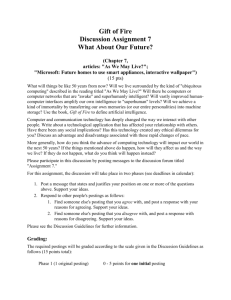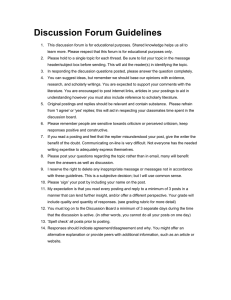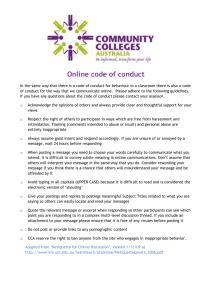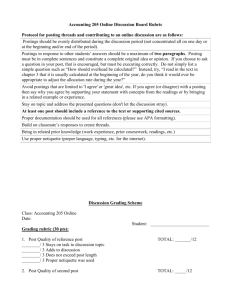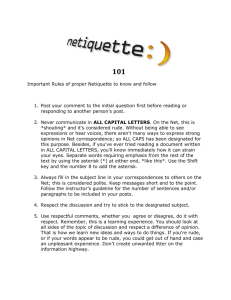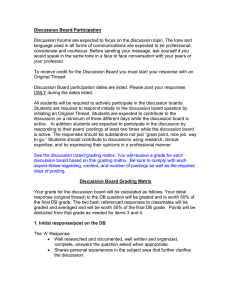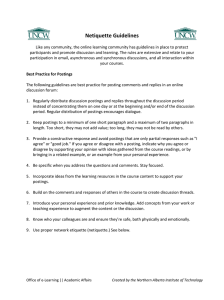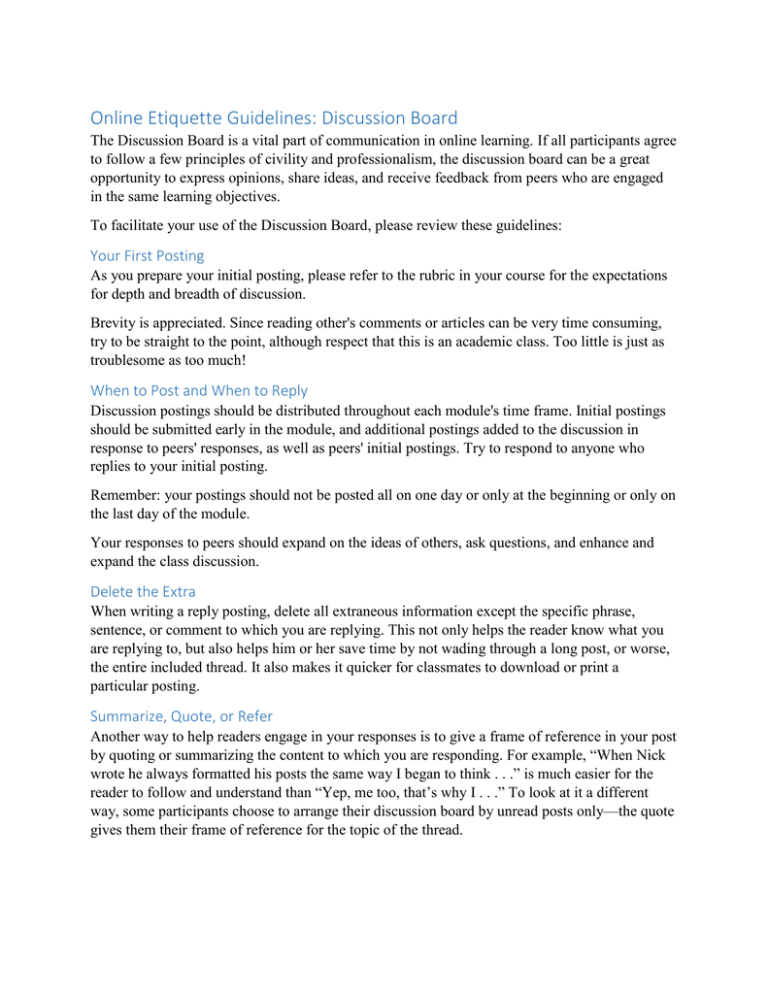
Online Etiquette Guidelines: Discussion Board
The Discussion Board is a vital part of communication in online learning. If all participants agree
to follow a few principles of civility and professionalism, the discussion board can be a great
opportunity to express opinions, share ideas, and receive feedback from peers who are engaged
in the same learning objectives.
To facilitate your use of the Discussion Board, please review these guidelines:
Your First Posting
As you prepare your initial posting, please refer to the rubric in your course for the expectations
for depth and breadth of discussion.
Brevity is appreciated. Since reading other's comments or articles can be very time consuming,
try to be straight to the point, although respect that this is an academic class. Too little is just as
troublesome as too much!
When to Post and When to Reply
Discussion postings should be distributed throughout each module's time frame. Initial postings
should be submitted early in the module, and additional postings added to the discussion in
response to peers' responses, as well as peers' initial postings. Try to respond to anyone who
replies to your initial posting.
Remember: your postings should not be posted all on one day or only at the beginning or only on
the last day of the module.
Your responses to peers should expand on the ideas of others, ask questions, and enhance and
expand the class discussion.
Delete the Extra
When writing a reply posting, delete all extraneous information except the specific phrase,
sentence, or comment to which you are replying. This not only helps the reader know what you
are replying to, but also helps him or her save time by not wading through a long post, or worse,
the entire included thread. It also makes it quicker for classmates to download or print a
particular posting.
Summarize, Quote, or Refer
Another way to help readers engage in your responses is to give a frame of reference in your post
by quoting or summarizing the content to which you are responding. For example, “When Nick
wrote he always formatted his posts the same way I began to think . . .” is much easier for the
reader to follow and understand than “Yep, me too, that’s why I . . .” To look at it a different
way, some participants choose to arrange their discussion board by unread posts only—the quote
gives them their frame of reference for the topic of the thread.
Me, Too, I Agree!
The me-too post certainly is a frustration in the online environment and does not add any depth
to the discussion or learning. In a study by Stodel, Thompson, and MacDonald (2006), “Learners
got frustrated with the constant agreements and comments such as ‘Good point’ and ‘I agree’;
feeling it made the conversation overly positive and fake.” Therefore be sure to post substantive
ideas and avoid the "I agree" posts which just clutter up a discussion board.
Change the Subject Line to Reflect the Content of your Post
Think of the subject line of your posting like the title of a good book, one which will draw other
readers in. Subject lines that resemble addresses (e.g., Lisa to Kay) tend to close down
discussions to just the two names listed. Subject lines that just repeat the original poster’s subject
line with the Re: added (Re: Re: Re: Unoriginal subject line) give no indication to the reader if
the new or added content will benefit him or her as a learner, whether the conversation has
evolved in topic or perhaps if it is veering off into a personal side conversation (which should
then be moved to the student lounge or email). Each time you post or reply to a post, update the
subject line to match the content of your posting.
Tone and Courtesy in Writing
The "tone" is a very important part of electronic communication. When you read your message
out loud, does it sound the way you would speak to another student in the classroom?
Humor can be difficult to convey in text, so make sure everyone realizes when you are trying to
be funny. It is easy for messages to be misinterpreted since there are no physical gestures or
voice inflections that accompany the text.
Think through and re-read your comments before you post them.
Be nice. Refrain from inappropriate language and derogatory or personal attacks.
Make a personal commitment to learning about, understanding, and supporting your
peers.
Assume the best of others in the class and expect the best from them.
Disagree with ideas, but avoid challenges that may be interpreted as a personal attack.
Be open to be challenged or confronted on your ideas or prejudices.
Challenge others with the intent of facilitating growth. Do not demean, harass or
embarrass others.
Encourage others to develop and share their ideas.
Check Previous Postings Before You Post
Remember to read what has previously been posted by others to avoid repeating comments.
Make sure you are posting under the appropriate heading or thread.
Stick to the topic; if you wish to pursue an unrelated idea with a classmate, move your
communication to e-mail so that others don't spend time on non-essential topics.
Give Credit Where Credit is Due
Cite your references.
Grammar, Spelling and Fonts
The Discussion Board is part of a college course, so your writing style should conform to the
rules of standard English. Here are some guidelines for all messages posted to the course's
Discussion Board and course-associated emails:
Avoid slang (e.g., "Wassup?", "Yo," and so forth).
Don't curse.
Use standard spelling:
you (not u)
are (not r)
to or too (not 2)
you're (not ure)
right (not rite)
I (not i)
Use the spell check! Mistakes in spelling and grammar reflect poorly on you, and they're
not acceptable.
Stick to standard fonts -- Times New Roman, Arial, Helvetica, 12 or 14 pt. -- and colors - black or blue.
DON'T WRITE THE ENTIRE POSTING WITH YOUR CAPS LOCK ON. IT'S
REALLY ANNOYING.
Adapted from University of Wisconsin - Stout: Adapted and used with permission of:
Lehmann, Kay and Lisa Chamberlin (2009).Making the Move to eLearning: Putting Your Course Online, pp. 141-145. Rowman & Littlefield
Education Publishers. (Available in hard back, soft cover, and Kindle)
© Copyright 2010 Kay Lehmann and Lisa Chamberlin All Rights Reserved

